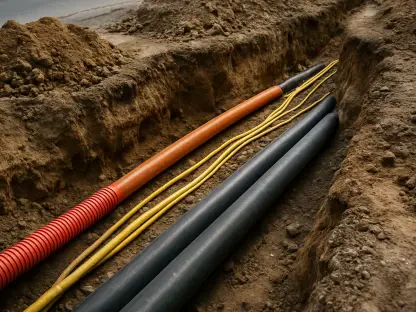The New Jersey Board of Public Utilities (NJBPU) is facing intense scrutiny from local officials and residents over its handling of safety and transparency concerns related to a planned 6,400 MW offshore wind transmission line. This project, set to run through Sea Girt, Manasquan, Wall Township, and Howell, has sparked extensive debate and apprehension. Recent meetings have not only revealed a series of unresolved questions but also pointed to some apparent inconsistencies in the information supplied by the NJBPU.
Community members have long expressed frustration over the NJBPU’s approach to addressing their concerns. Despite numerous requests from local mayors for a more interactive meeting, when the NJBPU finally convened, the session lacked a Q&A segment, leaving many questions unanswered and exacerbating the distrust among residents. These residents were keen on obtaining transparent and comprehensive information about the project’s expected impact. Questions mainly revolve around the safety and the potential environmental impact of the offshore wind transmission line. While there is a broad consensus on the necessity of clean energy, critics argue that offshore wind is both the most expensive and the riskiest renewable option compared to other viable alternatives.
The Community’s Growing Concerns
Meetings Without Answers
The frustration in the community has been palpable, with many residents feeling that their voices and concerns are not being adequately addressed by the NJBPU. The absence of a Q&A segment in the meeting was seen as a significant oversight by the NJBPU, leading to a perception of opacity and avoidance. This lack of direct communication has only deepened the residents’ mistrust, compelling them to seek more forthright and transparent disclosures regarding the project’s implications.
While the NJBPU did present projected increases in New Jersey’s electricity demand over the next decade, which faced little opposition, the more pressing concerns about the transmission line itself remained grossly unaddressed. Glenn Hughes, a resident vocal about his reservations, highlighted that no comparable project matches the scale and proximity of the planned transmission line to residential areas, casting further doubt on the reassurances given by NJBPU representatives. This disconnect between presented data and community concerns has drawn a clearer line between the supporters and critics of the offshore wind project.
Comparing Projects: Fact or Fiction?
During the meeting, Nick Baldanko, an engineer from Levitan Associates representing the NJBPU, made an attempt to reassure residents by comparing the project to other similar existing transmission lines. However, Hughes and other critics strongly rebutted these claims, stating that no existing project matches the unique scale and proximity to residential areas as the planned transmission line does. This assertion fundamentally questions the validity of the comparisons made by Baldanko.
Catherine Luthin, an energy expert attending the meeting, stressed the project’s uniqueness and the necessity for comprehensive studies to thoroughly understand its impact. The inconsistencies in Baldanko’s claims—initially suggesting the existence of similar projects and then admitting the absence of direct comparisons—have only added fuel to the residents’ growing mistrust and have intensified calls for more transparency from the NJBPU. This contradiction has made it all the more crucial for the NJBPU to provide clear, consistent, and comprehensive information to regain public trust.
Environmental and Safety Concerns
Protected Zones and Superfund Sites
Adding to the complexities of this project are the significant environmental concerns tied to its planned pathway. The proposed transmission line’s route through protected NJ State and Monmouth County environmental zones has raised critical alarms. These areas are significant for conservation and biodiversity, and any major construction activities could have lasting adverse effects on these sensitive environments. This has led many to question the thoroughness of the NJBPU’s preparatory research and the potential ecological impacts that might have been overlooked.
In addition to these conservation areas, there is also grave concern about the line passing through an active EPA Superfund site. This factor underscores the necessity for an exhaustive environmental study before any construction begins. Critics argue that these risks demand more rigorous and detailed environmental assessments to fully grasp the extent of potential damage. Without such studies, moving forward with construction would be not only irresponsible but potentially harmful to the ecosystem and public health.
Lack of Detailed Underground Maps
Another major technical concern discussed during the meeting was the lack of detailed underground maps showing the exact locations and depths of existing utilities. This information is vital to ensure minimal disruptions during construction and to avoid potential hazards that could arise from damaging existing infrastructure. The absence of these maps poses a significant risk of unforeseen complications, further adding to community unease.
Nick Baldanko mentioned various burial depths for the transmission lines during his presentation, contributing further to the confusion. He stated that lines would be buried at depths ranging from 3 to 5 feet and occasionally down to 15 feet. However, a letter from Sophie Dolashewich of the NJBPU cited burial depths of 3.5 to 8 feet. This discrepancy highlights inconsistencies that have left residents more skeptical and worried. Accurate and consistent information regarding the technical specifics of the project is essential to calming these fears and fostering a sense of security.
Calls for Comprehensive Studies
The Necessity of Exhaustive Research
The lack of conclusive scientific proof surrounding the safety of the planned transmission lines has emerged as a major focal point for many critics. Sea Girt resident Madeline McCarthy articulated this concern poignantly, calling for extensive studies to ensure the project’s safety and alleviate any potential health risks. The notion of conducting thorough research before proceeding has resonated widely among the residents, reflecting their demand for empirical data to accurately gauge the project’s safety and environmental impact.
Comprehensive studies would provide the necessary empirical data to understand the full scope of potential health and environmental risks. Proponents of this approach argue that without such detailed and rigorous analysis, pushing forward with construction would not only be ill-advised but could lead to unforeseen consequences. It is a matter of due diligence that many believe the NJBPU must undertake to address the community’s concerns adequately.
Building Trust Through Transparency
Throughout the pre-meeting communications and the meeting itself, the NJBPU’s inconsistent responses have further undermined their credibility in the eyes of many residents. Clear and consistent information is crucial for building public trust and ensuring that the community feels secure in the knowledge that their concerns are being taken seriously. The discrepancies in statements regarding burial depths of transmission lines and the overall safety comparisons of similar projects have only intensified calls for transparency.
Residents and local officials are increasingly demanding more reliable data and honest communication from the NJBPU. Addressing these concerns openly and forthrightly could start to rebuild the fractured trust between the NJBPU and the community. By adopting a more transparent approach and providing detailed, consistent information, the NJBPU can move towards a more collaborative effort in addressing the need for clean energy while ensuring community safety.
The Road Ahead for Offshore Wind Energy
Balancing Clean Energy and Safety
The New Jersey Board of Public Utilities (NJBPU) is under intense scrutiny from local officials and residents for how it has handled safety and transparency issues related to a proposed 6,400 MW offshore wind transmission line. This project, which is slated to pass through Sea Girt, Manasquan, Wall Township, and Howell, has ignited substantial debate and concern. Recent meetings highlighted numerous unresolved questions and apparent discrepancies in the information provided by the NJBPU.
Community members have voiced their frustration with the NJBPU’s response to their safety and environmental concerns. Even though local mayors had repeatedly called for a more interactive meeting, the NJBPU’s recent session lacked a Q&A segment, leaving many questions unanswered and deepening residents’ distrust. These residents were eager for clear and comprehensive details about the project’s anticipated impact. While there is broad support for clean energy, critics argue that offshore wind is the most expensive and riskiest renewable option compared to other available alternatives.









